
GEOCICHLA LITSITSIRUPA (Smith).
S O U T H -A F R IC A N G R O U N D -T H R U SH .
Merula litsitsirupa, Smith, Rep. S. Afr. Exped. App. p. 45 (1846).
Turdus strepitans, Smith, 111. Zool. S. A£r. pi. xxxvii. (1839).
Turdus crassirostris, Licht. Verz. siidafr. Faun. p. 14 (1842).
Psophocichla strepitans, Cab. J. f. O. 1860, p. 182.
Turdus litsitsirupa, Sharpe, Cat. Coll. Afr. B. p. 20 (1871).
Geocichla litsitsirupa, Seebohm, Cat. Birds Brit. Mus. v. p. 182 (1881).
G. supiA grisescens: subalaribus et axillaribus aurantiaco-fulvis: remigibus omnibus intus aurantiaco-fulvis: subtus
alba, maculis prsepectoralibus ovatis nigris : pectore et corporis lateribus maculis mgns tnangulanbus
oraatis.
T he present species has a somewhat wide distribution in South Africa, but does not occur in the
more southern districts of the Cape Colony. Mr. E. L. Layard says that he has received specimens
from Colesb6rg and Kuruman (B. S. Afr. 1867, p. 127). Sir Andrew Smith states that immediately
on reaching Kurrichaine this Thrush began to appear in the thickets, and he continued to acquire a
specimen occasionally, even in the vicinity of the Tropic (Zool. S. Afr. text to pi. xxxvii.).
It must be rare in Natal, as I have never seen a specimen from that colony, but Captain Shelley
states that he-saw one which had been killed near Durban (Ibis, 1875, p. 73). Messrs. R. B. and
J. D. S. Woodward have procured three single examples during their travels in Zululand, and these
were obtained at Eschowe, Ulundi, and the Ivuna River below the Nangoma range. Specimens are
in the British Museum from the Transvaal, where it is not uncommon among the mimosas (Ayres,
Ibis, 1877, p. 243). Mr. Ayres has also obtained it on the Limpopo (Ibis, 1867, p. 293). Mr. Symonds
met with the species near Kroonstad, in the Orange Eree State ; he states that it is common and
breeds in the vicinity of that town (Ibis, 1887, p. 330). In the Seebohm Collection is a pair of
birds procured by Mr. W. Lucas at Rustenberg, in the Eastern Transvaal, in June. The late
Mr. Frank Oates also shot a pair on the Eland’s River (Oates, Matabeleland, p. 307), and during
his expedition to Matabeleland Mr. T. E. Buckley noted that it was not often seen in the
Transvaal (Ibis, 1874, p. 369). In Bechuanaland it has been obtained by Dr. Exton, who gives the
native name as “ Chu-chu-roo-foo ” (Sharpe, ed. Layard’s B. S. Afr. p. 198).
Mr. Frank Oates likewise met with the species at Tati in March ( c f Oates s Matabeleland,
p. 307), and some specimens collected by the late Dr. Bradshaw in the Makalaka country are in the
Shelley Collection in the British Museum. Mr. T. Ayres says that it was found scantily scattered
throughout Mashonaland (Shelley, Ibis, 1882, p. 250). So far as is at present known, its eastern
range does not extend across the Zambesi, as it has not been met with in Nyasaland by Sir Harry
Johnston or any of his assistant collectors.
In South-western Africa it would appear to be not uncommon, as Andersson sent many
specimens from Damaraland, where, he says, the species is partially migratory, only a few-remaining
throughout the year. According to the same observer, it occurs in the Lake Regions and also extends
to Great Namaqualand (B. Damaraland, p. 114). Professor Barboza du Bocage (Orn. Angola, p. 26o)
p 2